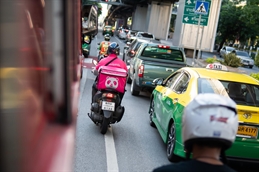
The common need to minimize delivery times and disruptions even in very different segments of the cold chain industry was a key theme of the Asia Cold Chain conference in Bangkok last month.
One area where that is particularly important is in the last mile section, as two very different companies pointed out. Both Foodpanda, which delivers restaurant food to consumers, and HappyFresh, which delivers groceries, agreed that the key thing to successful delivery is minimizing bag time.
Each company has a different requirement and a different approach.
HappyFresh works by having personal shoppers in various supermarkets train staff members to pick the freshest fruit and vegetables possible, HappyFresh managing director Grzegorz Sagan told the conference.
By contrast, Foodpanda “leverages a lot on technology,” said Bhavani Kumar Mishra, the company’s director of operations. In practical terms, consumers are encouraged to order from nearby restaurants and from cookeries which are prompter. “We base it on distance,” Mishra said, with nearby outlets and faster cooks being higher on the list consumers see on their mobile app.
Both companies then use drivers, albeit very different types, to deliver their orders.
“We have our own fleet of motorbikes,” said Sagan, adding that its drivers are full-time employees of the company. Having them as members of staff allows HappyFresh to maximize quality and fulfilment, he said. Larger orders are sometimes moved by cars and four-wheel-drive vehicles.
Foodpanda, which handles multiple on-demand consumers, with spikes in business during meal times, relies upon an army of riders spread throughout its delivery areas in the Asia Pacific and elsewhere.
This is not the management nightmare it could be, as technology on the platform generates the work assignments and manages some of the money, though the cash on delivery still represents a sizable chunk of the delivery business.
Training to be a Foodpanda delivery driver is stringent, according to Mishra, although it is condensed into one day. The company also has a ranking system which favours good drivers and limits those who are less efficient.
Some of the lessons learned from individualized deliveries, such as the Foodpanda or e-commerce models, can be applied to other sectors of the delivery business, despite also having many differences from food delivery.
As life sciences and biotech evolve, health care is evolving from one type of medicine or one type of procedure being applied to all patients with the same need to self-centric care, where individualized treatments are prescribed for each patient. The comparison drawn is to e-commerce with individual packages going to one person at a precise time.
One difference, though, shouldn’t be forgotten. As well as the complexity of some of the medicines, which makes their movement a much more complex and onerous task, some need to be stored at -40°C, and there is also an issue of their toxicity to consider. Cancer serum, if spilled in a room, will affect everybody, Rangsima pointed out.
This adds to the need for “fully-trained drivers,” said Serene Ong, vice president of commercial operations, APAC, at Marken, a part of UPS which specializes in moving high-value but small-batch medicines.
Even then, the drivers are not staff but are trained by Marken staff and seemingly to a high degree, as drivers have to go through good clinical practices, good distribution practices and good manufacturing practices training. This is both theoretical and practical and is done annually. Ong says the training is needed so that the delivery drivers can better understand the product they are handling and how to manage it.
Marken, which has a dedicated global control centre monitoring the 70,000 shipments moving on its network each month, steps in when it notices any breaches in conditions.
There is, though, an unusual problem with infrastructure and its attendant software which even China’s mighty Belt and Road Initiative might be slow to shift.
While infrastructure will be built – including roads and rail networks – that will tie China to Europe and allow goods to be moved faster, there are still no high-quality road trucking services to move goods safely, said Brett Marshall, corporate head of quality assurance for Singapore-based Zuellig Pharma.
Sea freight, while it might be slower, is attractive on the grounds of cost and security as new technology allows the well-being of reefers to be monitored thoroughly throughout a voyage, he added.
The other problem is that new land routes are not yet working as planned. “It takes longer than you think,” said Rangsima Simargool, head of distribution for Thailand, the Philippines and Vietnam at Merck.
By Michael Mackey
Southeast Asia Correspondent | Bangkok



